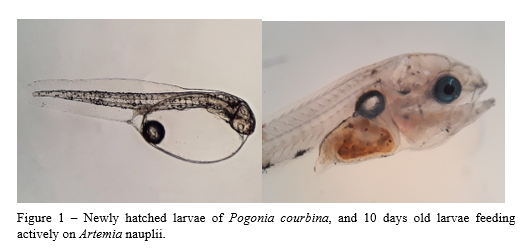REPRODUCTION AND LARVICULTURE OF THE SOUTHERN BLACK DRUM Pogonias courbina, A NEW SPECIES FOR AQUACULTURE IN SOUTH AMERICA
Introduction
Marine fish culture is an emerging industry in the Western South Atlantic coast. Two species are currently commercially produced in Brazil, the cobia Rachycentron canadum (Sampaio et al 2010) and the grouper Epinephelus (Mello et al, 2018). Nevertheless, there is a continuous search for prospective species.
Sciaenidae fish are produced in North America and Europe, aquaculture production for red drum (Sciaenops ocellatus) reachs 77,000 ton, while meagre (Argyrosomus regius) 37,500 ton (FAO 2021), thus suggesting other large Sciaenidae species, such as endangered Southern black drum (Pogonias courbina) would also have good aquaculture potential.
This is the first report of successful mass production of juvenile Southern black drum P. courbina.
Materials and Methods
Twenty adult fish were captured during the winter 2019 (from July to September) at Cassino Beach, in Southern Brazil (32°S-52°W), and immediately transferred to the Laboratory of Marine Fish Culture at FURG. They were measured, tagged, and stocked in a 15 ton tank, attached to a RAS. Water temperature and photoperiod at the hatchery mimicked the conditions in the wild. Broodstock were hand fed daily on frozen fish, squid, and shrimp.
Live feed was provided to the larvae, including microalgae (Nannochloropsis oceanica), rotifer (Brachionus plicatilis), and Artemia sp (nauplii and metanauplii). Rotifer and Artemia metanauplii were enriched using commercially available lipid emulsions rich in HUFA (Red pepper – Bernaqua). During cofeeding, up to weaning, larvae were offered commercial diets (Win Fast – Sparos and NRD – Inve).
Larvae were reared in 300 L tanks attached to a RAS. Continuous light was provided during larviculture, temperature was kept at 26°C and salinity was set to 30‰.
Results
Four months after the last broodstock were stocked in the hatchery, during January 2020, naturally fertilized eggs of P. courbina were obtained for the first time. At the time of spawning water temperature was 26°C and photoperiod was equal to 14 h light and 10 h darkness. The precise moment of spawning was not determined, but in the morning, embryos often had already reached the 180° stage, hatching took place between 9 and 12PM. Newly hatched larvae measured 1.9 mm.
Exogenous feeding started 48 h after hatching, larvae were fed exclusively on rotifers for 5 days, when Artemia nauplii was introduced. Rotifers were discontinued 11 dah and Artemia nauplii 13 dah, when larvae were fed only enriched Artemia (Figure 1). Co-feeding with dry diets began 15 dah and larvae were fully weaned 22 dah. One month after hatching larvae reached 29 mm and weighed 270 mg. Survival up to metamorphosis was between 75 - 90%.
Discussion and conclusion
One of the first steps towards the introduction of a new species for aquaculture is to accomplish its controlled reproduction in captivity (Mylonas et al 2010). Wild caught broodstock of Southern black drum readily adapt to captivity and were conditioned to spawn volitionally.
Larviculture of teleost fish is dependent of live food, but their larvae should be readily be weaned into dry diets, therefore reducing the need for live prey production and the high costs associated to production of rotifers and purchase of Artemia cysts (Campoverde et al, 2017).
Larviculture of Southern black drum larvae is faster than most species. Larvae were fully weaned as soon as 22 dah. Survival was also high, up to 90% upon completion of metamorphosis.
The successful mass production of striped drum juveniles suggests it may be a prospective species for aquaculture in South America.
References
Campoverde, C.; Rodriguez, C.2 | Perez. J.; Gisbert, E.; Estevez, A. 2017. Early weaning in meagre Argyrosomus regius: Effects on growth, survival, digestion and skeletal deformities. Aquaculture Research, 48: 5289-5299.
FAO. 2021 Aquaculture production 1950–2019. FISHSTATJ – Software for Fishery and Aquaculture Statistical Time Series.
Mello, P.H., Araújo, B.C., Campos, M.F., Rodrigues-Filho, J.A., Garcia, C.E.O., Moreira, R.G. 2018. Embryonic and larval development and fatty-acid profile of Epinephelus marginatus spawned in captivity: Tools applied to captive rearing. Journal of Fish Biology, 92, 1126-1148.
Mylonas, C.C., Fostier, A., Zanuy, S. 2010. Broodstock management and hormonal manipulations of fish reproduction. General and Comparative Endocrinology, 165: 516-534.
Sampaio, L.A., Moreira, C.B., Miranda-Filho, K.C., Rombenso, A.N. 2011. Culture of cobia Rachycentron canadum (L) in near-shore cages off the Brazilian coast. Aquaculture Research 42: 832-834.
Acknowledgements
The authors would like to thank Brazilian CNPq-MCTI, CAPES, and FAPERGS. The support of European Community (AquaVitae Project – H2020 SC2) is also appreciated. L.A. Sampaio is a research fellow of CNPq.
